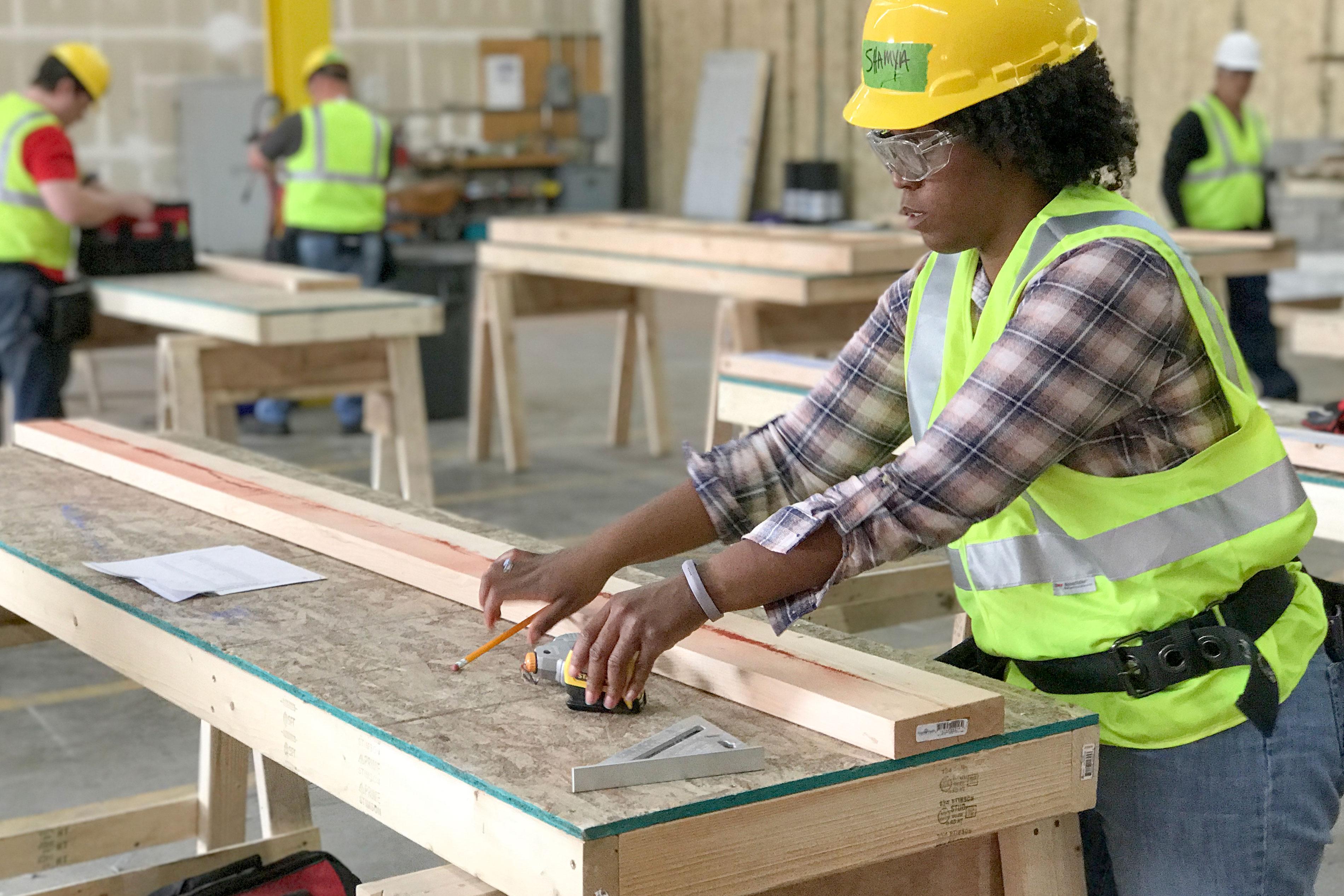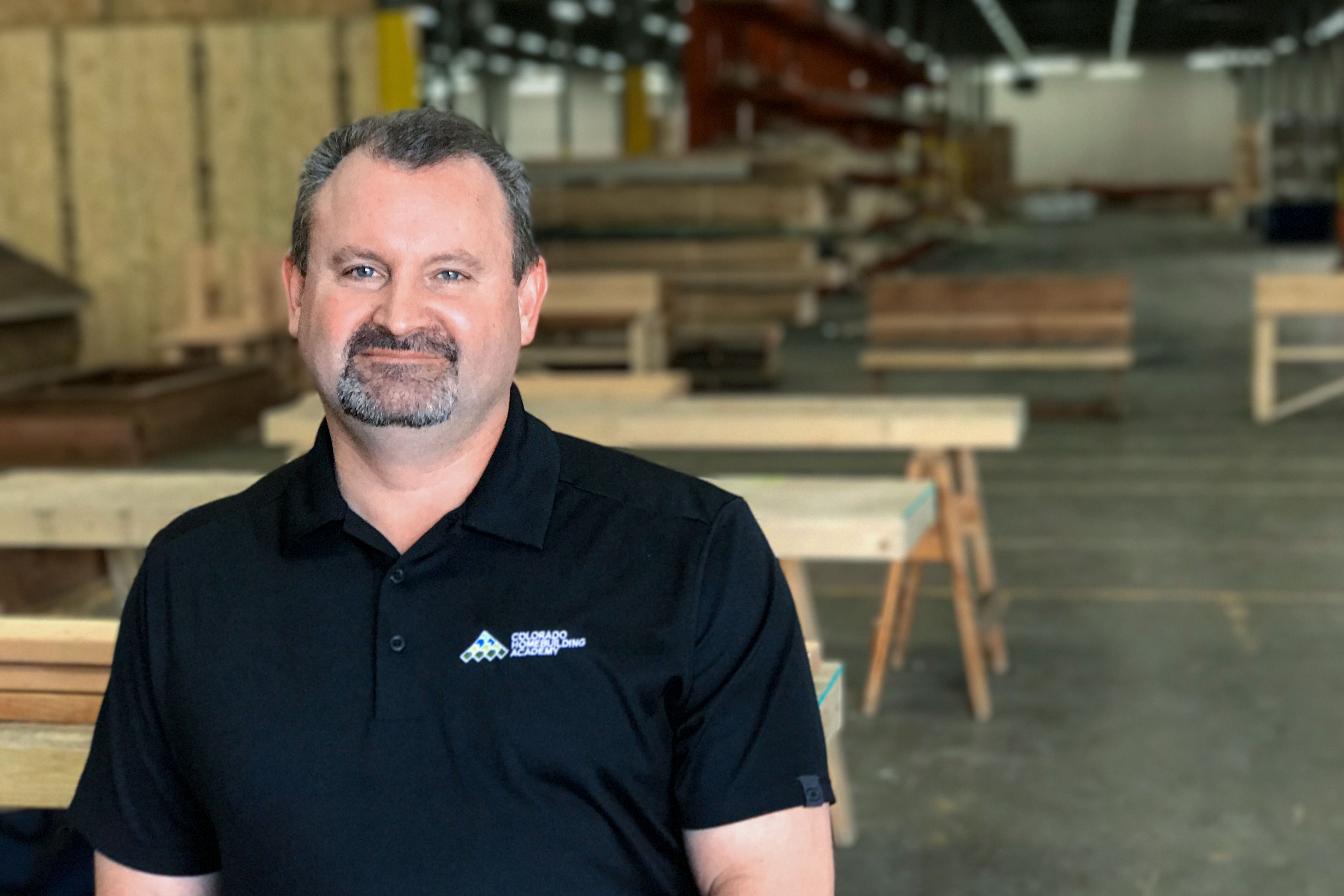

The Colorado Homebuilding Academy is an effort to get more people to work. People like Shimai Hunter.
“I don’t have any construction experience,” Hunter says. “I actually come from a case management background.”
No experience? No problem. The core of the program — what director Michael Smith calls their textbook — is half of a two-story house, most of its guts still exposed, standing in a warehouse near Denver’s Globeville neighborhood. The space around the house is littered with sawhorses and workstations. Hunter says the program was intimidating at first.
“But once you start touching the products and feeling you know, the tools, what a two by four is and how you cut it, and cutting it at 45 degree angle, it changes everything,” she says. “Like I look forward to it.”
The workstations, setup to teach you how to install a door, a window or a roof, are where students learn the basics of homebuilding over an 8-week evening course. Hunter hopes to become an electrician.
The school is unlike anything else available in the state, says Smith. And by going through the program, students will be better prepared to join a work crew.
“I don’t want to see the first time you’re ever working 8-feet off the ground, to be the first day of work,” he says. “And you know, you’re not very productive, you don’t feel safe. So why not have an environment where you can take the scaffolding, set it up, work 8-feet in the air to get comfortable with it?”

Smith says the best way to make newcomers feel welcome in construction is to set them up for success. And the industry needs newcomers desperately. Today, there are around 15,000 fewer construction workers in Colorado than there were in 2007, when the state hit its peak. The Great Recession killed off lots of labor jobs.
“We chased a lot of people out of our industry who said, ‘I’m not going back.’”
The consequences can be felt in people’s pockets. The challenge is building a house that’s in an attainable price range. For Smith a lot of that is, “done by us investing in and training a workforce ahead of time so they can build that product faster. And faster means cheaper.”
That’s what Pat Hamill, CEO of Oakwood Homes, had in mind when he contacted Smith with the vision for the construction school. And that vision is growing — the school has doubled its class sizes since its start in January, adding more instructors and courses. Hamill says his company has invested a few million dollars to get the academy running.
“Our hope is to get other builders involved and other builder’s trade contractors, and really creating a pipeline,” Hamill says. “We’ve just done a poor job of educating and showing that you can have a really great career in the housing industry.”
Anthony Lee Lucero graduated from the program three months ago, and is now working as a maintenance technician. Before, he was in food service for 30 years.
“I just got tired of the kitchen industry,” Lucero says. “I was there too much and not getting paid for it.”
He’s also looking forward to the health benefits. He smiles, and shows a bottom row of missing teeth. They were knocked out when he was younger, he says, and he hasn’t been able to replace them.

“Unfortunately because of the kitchen, you know, they would always switch insurance and you know, we never had a steady plan. And it’s sad, but true.”
The cranes towering over Denver’s skyline show him construction is the place to be. It was work he did part time years ago and he’s happy to be a part of it again.
“I wish I would have never left the industry, because I’d be further off than I am now,” Lucero says. “But hey, it just goes to show you’re never too old.”
The program didn’t cost Lucero of Shimai Hunter any money. Student tuition is sponsored by either Oakwood Homes, another industry company, or partners like the Denver Urban Renewal Authority. Michael Smith says most students complete the course, and 90 percent of those are employed in the industry. They expect 350 students to graduate this first year. Next year’s goal is 1,000.
“I know we’re making an impact when we talk to our employer partners, and they call up just to say thank you,” Smith says. “And can I have another? May I have another graduate to be able to come into our workforce? Is it enough? Not enough today. But it could be.”
Even if Smith hits his goal, it would take more than a decade to fill the work gap. A gap that continues to grow along with a demand for homes that get less affordable by the day. If more isn’t done to recruit construction workers, that trend won’t change anytime soon.









